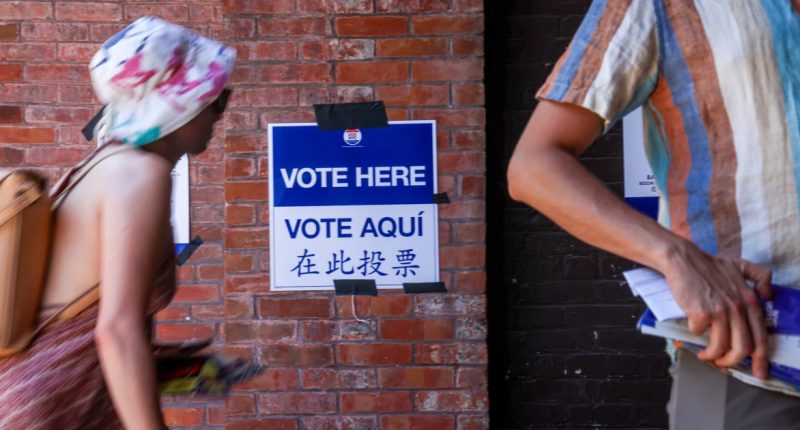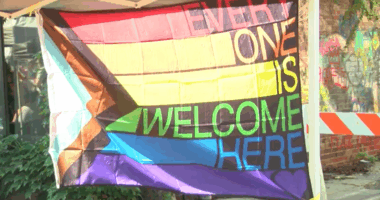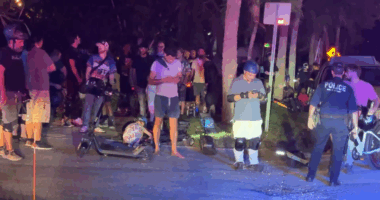Share this @internewscast.com

The recent mayoral primary in New York City has brought fresh attention to the country’s ongoing trial with ranked choice voting, reigniting discussions about this relatively new and complex system.
New York City is one of 63 areas, including various cities, states, and counties, that have adopted ranked choice voting for some or all of their elections in recent years.
Proponents of the system claim it provides lesser-known candidates with better chances to succeed and pushes politicians to reach wider agreement and expand their appeal, as voters are allowed to select multiple candidates on their ballots.
Critics have pointed out that tabulating ranked choice ballots takes longer and delays final results and contend the system sows confusion among voters.
Tuesday’s election may end up providing both sides with fresh data points for their arguments. Final results of the Democratic primary for mayor most likely won’t be known until next week, even as former Gov. Andrew Cuomo conceded to state Assemblyman Zohran Mamdani.
Supporters of the system say the campaign to lead American’s biggest city — which used ranked-choice voting for just the second time in a mayoral primary election — shows voters and candidates alike are acclimating to the system.
“What we’ve seen in the mayoral race is a better understanding among more candidates of ranked choice voting,” said Susan Lerner, the executive director of Common Cause New York, a government watchdog and reform advocacy group that has advocated for ranked choice voting.
“That ranked choice allows you to cross-endorse, allows you to speak to more voters, that you don’t just have to focus on the people who have already decided you are their one and only choice,” she said in an interview ahead of Tuesday night’s results. “We have seen that understanding really being applied more broadly in the mayoral primary.”
Lessons learned from 2021
The rules for ranked choice voting differ depending on where it’s used. In New York City, voters may rank up to five candidates in one race.
After the votes are tabulated, the last-place candidate is eliminated. Ballots from voters who supported that candidate then have their next choices counted. If no candidate has hit 50%, counting continues, eliminating another last-place candidate and counting the next-ranked choices on all those ballots in the following round.
Tuesday’s results showed Mamdani with 43.5% support in the first-choice count, compared with 36.4% for Cuomo. Since no candidate hit the 50% mark, city election officials will now begin to count voters’ second choices.
Mamdani, 33, who identifies as a democratic socialist, ran an energetic, digitally savvy campaign centered on tackling higher costs and progressive policy promises he said he’d pay for with taxes on the rich.
Deb Otis, the director of research and policy for the election reform group FairVote, said in an interview that the system, combined in New York City with the availability of public financing of campaigns, “lets candidates stay in the race and make their case to voters.”
That’s in part because the system offers candidates incentives to support one another. Mamdani secured cross-endorsements with several fellow candidates, meaning he and those candidates directed supporters to rank each other second on their ballots.
“If this were any of the cities that don’t use ranked choice voting, these progressive candidates would have been sniping at each other the whole time and pushing each other to drop out so that they don’t split the vote,” Otis said. “Instead, we see those candidates all able to run, instead of shoving each other out of the race. And I think that that’s better for voters.”
Critics of New York City’s system have emphasized the delays ranked choice tabulation creates in releasing official results — a particular concern amid the rise of false allegations of widespread voter fraud made by President Donald Trump and his allies.
“There’s already lots of questions of trust in the [election] process — we are at point in the world where trust in the democratic process is low and flagging,” said Sam Oliker-Friedland, the executive director of the Institute for Responsive Government, which opposes ranked choice voting as a one-size-fits-all concept. “Part of implementing it properly is finding a way to count ballots at relatively the same speed that we’re counting ballots now and not adding a week or more than week to the ballot-counting timeline.”
Pointing to evidence from New York City’s maiden voyage with ranked choice voting in 2021, critics have also suggested voters may not fully understand how the complicated system works.
In the 2021 Democratic mayoral primary, 13.4% of voters ranked only one candidate, according to a CUNY Graduate Center analysis of the results, because either they chose to disregard or didn’t know that they could rank more.
In other ways, it became evident that candidates and other power players in New York City politics learned lessons from 2021.
For example, high-profile Democrats — most notably Rep. Alexandria Ocasio-Cortez, who backed Mamdani — issued their endorsements in detailed statements or videos that conveyed to voters how they should rank their slates of candidates.
And unlike in 2021, when two Democratic mayoral candidates effectively split the progressive vote, providing a clearer path for the more moderate Eric ams, liberals this time worked together in a concerted anti-Cuomo effort.
Rising ranked choice voting enthusiasm, followed by a retreat
The heightened national political focus on New York’s mayoral race could breathe new air into the debate over ranked choice voting — the expansion of which has plateaued in the United States after an explosive start just a few years ago.
Less than three years ago, voters in eight jurisdictions passed ballot measures adopting ranked choice voting. They included Alaska, which became the second state to use it in state and federal elections. Maine has used the system in state and federal elections since 2018. New York City adopted the system in 2019 for just a handful of city primary elections, including the mayoral primaries, and used it for the first time in 2021.
Meanwhile, other advances put the number of cities and towns that switched to ranked choice voting by 2022 at more than 50.
Progressives initially embraced the system as a way to help curb the influence and success of more establishment-friendly candidates, and conservatives and moderates began to see opportunity in the system for a short period of time before they turned against it. Seventeen GOP-controlled states have enacted laws banning ranked choice voting, and the Republican National Committee adopted a resolution formally opposing it in 2023.
More broadly, enthusiasm soon faded. Most of the legislation that sprouted in 2023 to implement or expand ranked choice voting failed. Last November, voters in all eight states where advocates had placed election reforms including ranked choice voting on their ballots — a group that stretched across the political spectrum — roundly rejected the proposals. In Alaska, an effort to repeal the state’s two-year-old ranked choice voting system failed.
After having spent more than $100 million in support of the ranked choice voting ballot measures, advocates said their failure was a product of established interests’ pushing back against something new.
But critics argued that the system is simply not meant as a cure-all for elections everywhere.
“Everyone would love to find the sort of gadget that’s going to save democracy. But ultimately, there are no silver bullets that are going to make everything better,” Oliker-Friedland said.
“That was sort of pitched that way to voters last year, and that message correctly failed — there is no social reform that is a magic bullet that works everywhere,” he said. “We have to do the hard work of pairing it to particular contexts.”

















